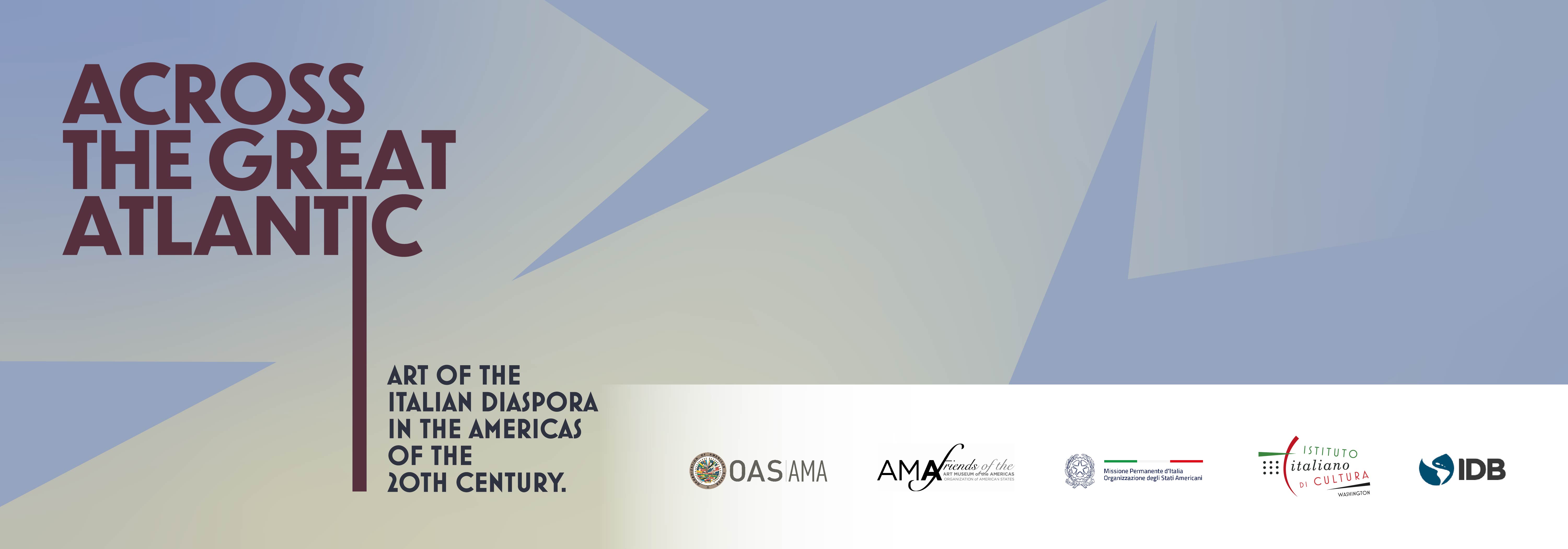
The OAS AMA | Art Museum of the Americas, the
Inter-American Development Bank (IDB) Cultural Center, the Permanent
Observer Mission of Italy to the OAS, and the Italian Cultural
Institute of Washington announce Across the Great Atlantic: Art
of the Italian Diaspora in the Americas of the 20th Century.
This exhibition features outstanding works by artists of Italian
descent in the Americas, from the AMA and IDB permanent collections,
and is part of a series organized by the AMA that examines the impact
of migratory patterns to the Americas on art of the region.
Across the Great Atlantic analyzes Italian migration to the
Americas from the mid-19th century through the 1940s and its
influence on American art. Exploring the dynamic intersection of
Italian heritage and American artistic expression, this exhibition
showcases the profound impact that American artists of Italian
descent had on the development of unique artistic identities, and
takes us on a journey through the different aesthetics that
characterized the region, from cubism and surrealism to abstract
expressionism and conceptual art.
During the 19th century, a
pattern of migration to the Americas took shape from several
European countries, most prominently from Italy, resulting in
significant cultural exchanges as early as the 1900s. Artists of
Italian descent played a critical role in shaping the visual arts in
the Americas and injecting societies with a new idea of modernity,
which would contribute to Latin America’s artistic boom in the 1950s
and 1960s.
Rather than concentrating on works addressing
migration, this exhibition focuses on the result of
multi-generational assimilation processes and the constant dialogues
between Italy and the Americas as a whole. The diversity of cultures
and their amalgamation across the western hemisphere is evident
through the selected works, that are drawn from areas including
abstraction, geometry, figure, places, and spaces, and dating back
to 1937 and into the 21st century.
“Tracing migratory paths
and the resulting artistic trends through the region is central to
our work as a museum and my focus as a curator, and it is a
privilege to work alongside the Permanent Observer Mission of Italy
to the OAS, the Italian Cultural Institute of Washington and the IDB
to highlight these themes through the strengths of our respective
collections,” says Adriana Ospina, director of the Art Museum of the
Americas.
Across the Great Atlantic celebrates the nuanced narratives woven
by these talented individuals, offering a tapestry that transcends
borders and encapsulates the essence of a truly global artistic
heritage with Italian roots. Join us as we explore the
transformative effect that these artists had—and continue to have—in
the rich and complex identity of the visual arts in the region.
Francisco “Paco” Amighetti Ruiz (Costa Rica)
Javier Bassi (Uruguay)
Ernesto Bazan (Italy)
Antonio Bellolio (Ecuador)
Antonio Berni (Argentina)
Alfredo Bigatti (Argentina)
Héctor Borla (Argentina)
Ary Brizzi (Argentina)
Sergio Camporeale (Argentina)
Domenico Cantatore (Italy)
Claudia Casarino (Paraguay)
Pietrina Checcacci (Brazil)
Jorge Damiani (Uruguay)
Claudio Fantini (Costa Rica)
Adolfo De Ferrari (Argentina)
Pedro Figari (Uruguay)
Lia Galletti (Cuba)
Candace Gaudiani (United States)
Teresa Ghiglino (Peru)
Umberto Giangrandi (Colombia)
Alberto Gironella (Mexico)
Hermann Guggiari (Paraguay)
Thomaz Ianelli (Brazil)
Humberto Ivaldi (Panama)
Juan Carlos Liberti (Argentina)
Robert Longo (United States)
Romulo Maccio (Argentina)
Mario Maffioli (Costa Rica)
Diego Masi (Uruguay)
Roberto Matta (Chile)
Ricardo Migliorisi (Paraguay)
Ad Minoliti (Argentina)
Guido Molinari (Canada)
Margarita Morselli (Paraguay)
Lyria Palombini (Brazil)
Jacques Palumbo (Canada)
Virginia Patrone (Uruguay)
Josefina Perazzo (Argentina)
Emilio Pettoruti (Argentina)
Maria Cecilia Piazza (Peru)
Cândido Portinari (Brazil)
Benito Quinquela Martín (Argentina)
Ramon Morales Rossi (Venezuela)
Felipe Secco (Uruguay)
Cristina Sicardi (Argentina)
Raúl Soldi (Argentina)
Fernando Tamburini (Dominican Republic)
Carlos Maria Tonelli (Uruguay)
Ed Viggiani (Brazil)
Oswaldo Viteri (Ecuador)

